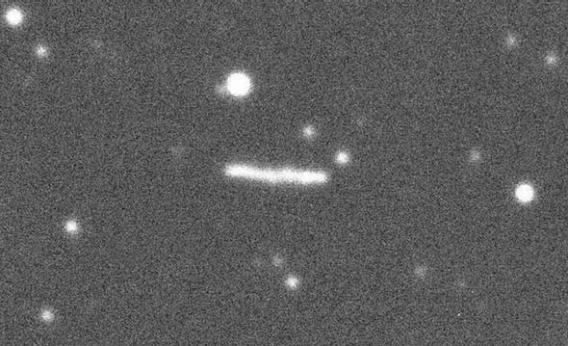Create a free profile to get unlimited access to exclusive videos, sweepstakes, and more!
Reminder: Finding Asteroids Is Hard

At 11:17 UTC (6:17 a.m. EST) today, the asteroid 2013 XY8 passed the Earth at a distance of just 760,000 kilometers (470,000 miles), less than twice the distance to the Moon. It orbits the Sun every 3.3 years, swinging out about halfway to Jupiter's orbit, and coming in to just inside Earth's orbit. Thereâs no danger from an impact from this space rock this time, and current data show it wonât come near the Earth again until 2072.
But XY8 is a good reminder that there are lots of asteroids out there, and we need to find them. And itâs also a good reminder that finding them isnât all that easy.
[UPDATE (Dec 11., 2013 at 15:00 UTC): The Virtual Telescope Project took enough pictures of XY8 as it passed us to create the dizzying video below of the asteroid speeding past us. Keep your eyes on the center of the video and you'll see XY8; the telescope tracked its motion so it looks like the stars are streaking past it.]
We can judge an asteroidâs size from knowing its distance and how bright it appears to be. It also depends on how reflective it is; a shiny asteroid can be smaller and look as bright as one thatâs darker and bigger. On average, asteroids reflect about 4 percent of the light that hits them; using that number XY8 to calculate its size we get itâs 30 â 70 meters across, or about the size of a basketball court on the lower end, and more than half a football field on the higher one.
Were that to hit the Earth â and again, it wonât, but just suppose â it would be pretty bad. Remember, the Chelyabinsk asteroid which hit Russia in February 2013 was only 19 meters across! XY8 is 5 to 50 times more massive, so it would make a pretty decent bang.
And hereâs the fun bit: XY8 was discovered just a few days ago, on Dec. 7. If it had been on an impact trajectory, weâd have only had five days warning.
Why was it discovered so late? Because even though itâs bigger than a house, itâs far away, which makes it very faint. When it passed us at closest approach it peaked at a magnitude of about 14, less than a thousandth as bright as the faintest star you can see with the naked eye. And in asteroid terms, thatâs when it was pretty close by! It was even fainter when it was discovered by the Catalina Sky Survey.
Of all the things about asteroid impacts to fret over, this is what worries me the most: finding them in the first place. The bigger an asteroid is the bigger the impact, of course, but also the easier it is to find it in the first place. Bigger rocks are brighter, and we can see them more easily. The problem is that thereâs a size range on the small end where they still do damage when they hit us, but are simply too small to find until theyâre very close.
Chelyabinsk was like that. Although it blew up high in the atmosphere, the shock wave from the blast shattered windows and injured over a thousand people. But we had literally no warning; it was too small and too near the Sun in the sky to be found before it hit us. For small impacts like that, the first time we see the asteroid will be when itâs streaking through our air.
There are about a million asteroids of decent size that cross Earthâs path, and weâve only charted about 10,000. That may sound like a lot, but itâs only 1 percent of whatâs out there.
Asteroid 2013 XY8 animation showing it moving over the course of just over two minutes. Photo by Ernesto Guido, Nick Howes, and Martino Nicolini using the Faulkes Telescope South.
Thatâs why I take this threat seriously. The chance of a catastrophic impact is low for any given time, but if we do nothing, it goes up to 100 percent. If we do nothing, then eventually an asteroid will hit us, and it doesnât take one a kilometer across to do terrible damage.
So what do we do?
We need more eyes on the sky! Part of the problem is that the sky is big, so youâre looking for a needle in a cosmic haystack. Asteroids are faint, so we need bigger telescopes looking. And we need them in both hemispheres (observatories in the north canât see asteroids coming in from the deep south because the Earth is in the way; the reverse is true for southern observatories), as well as spread out over many longitudes so that we have search programs looking day and night. We also need space-based observatories to look in parts of the sky near the Sun, where ground-based telescopes canât look.
The good news is weâre on this. NASAâs NEOCam and the B612 Foundationâs Sentinel are space-based observatories in the works. Both will look in the infrared where warm space rocks glow more brightly (and, Iâll note, B612 has ideas of what to do if we find one headed our way).
The Pan-STARRS observatory is already on the hunt (itâs found several asteroids and comets), and the LSST should be online in a few years as well. There are many other observatories looking for asteroids as well, so things arenât too bad.
But we can always use more. Asteroids are forever on the move, and one that is visible now may not be in a week, and wonât return for decades. This is ongoing work, and for our own safety itâs something that will never end.
Eternal vigilance is the price of freedom from going the way of the dinosaurs.
Tip o' the gravity tug to NASA's NEOCam on Twitter.


























